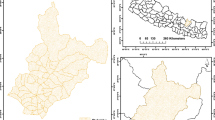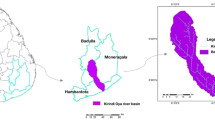Abstract
Soil erosion is a serious environmental problem impacting soil and water resources of the Himalayan region. To sustain food and fibres requirements of ever increasing population, there is need to rehabilitate erosion affected areas. In the present study, risk of soil erosion was assessed in the Soan river basin of sub-Himalayan region of Pakistan using Revised Universal Soil Loss Equation coupled with geo-informatic techniques. The influential factors leading to higher erosion rates were studied under variable scenarios of environmental change. The study revealed an average soil loss of about 8.4 tons/ha/year in the study area. The intensity of erosion was predicted around 15 tons/ha/year in the open soil and 10.3 tons/ha/year in the agriculture land. The rate of erosion was found maximum over 5°–15° slope, i.e., about 19 tons/ha/year. At steeper slopes (i.e., > 15°), the lower values of erosion rates were observed likely because of presence of exposed rocks lacking extensive soil cover. High risk of erosion was predicted in scenarios of increase in rainfall and conversion of rangeland and scrub forest into agriculture land in the basin. The menace of soil erosion can be controlled through adopting integrated land use planning and soil conservation approach at micro to macro level in this part of the Himalayan region.











Similar content being viewed by others
References
Abuzar MK, Shakir U, Ashraf A, Mukhtar R et al (2018) GIS based risk modeling of soil erosion under different scenarios of land use change in Simly watershed of Pakistan. J Him Earth Sci 51(2A):132–143
Ahmad F (2013) Land degradation pattern using geo-information technology for Kot Addu, Punjab Province. Pakistan. Glob J Hum Soc Sci 13(1):1–6
Alam S, Fatima A, Butt MS (2007) Sustainable development in pakistan in the context of energy consumption demand and environmental degradation. J Asian Econ 18:825–837
Almeida-Guerra P, Napolitano R and Feoli E (2012) Importance on soil erosion prevention for environmental risk alert by the application of remote sensing and GIS techniques. A case study in Santos (Brazil). http://www.academia.edu/1586230/. Accessed 14 Aug 2018
Ananda J, Herath G (2003) Soil erosion in developing countries: a socio-economic appraisal. J Environ Manage 68:343–353
Angima AD, Stott DE, O’Nell MK, Ong CK, Weesies GA (2003) Soil erosion prediction using RUSLE for Central Kenyan Highland Conditions. Agr Ecosyst Environ 97:295–308
Arnoldous HML (1980) An approximation of rainfall factor in the universal soil loss equation. In: De Boodt M, Gabriels D (eds) Assessment of erosion. Wiley, Chichester, pp 127–132
Ashiagbor G, Forkuo E, Laari P, Aabeyir R (2013) Modeling soil erosion using RUSLE and GIS tools. Int J Remote Sens Geosci 2:7–17
Ashraf A, Ahmad MM, Ahmad Z (2016) River basin management in the Himalayan Environment. A case of Soan River Basin, Pakistan. LAP LAMBERT Academic Publishing at http://dnb.d-nb.de. Accessed 25 Oct 2017
Ashraf A, Abuzar MK, Ahmad B, Ahmad MM, Hussain Q (2017) Modeling risk of soil erosion in high and medium rainfall zones of Pothwar Region, Pakistan. Proc Pak Acad Sci 54(2):67–77
Auerswald K (1987) Bestimmung der Bodengründigkeit aus dem Klassenbeschrieb der Reichsbodenschätzung zum Festlegen von tolerierbaren Bodenabträgen (T-Wert). [Estimating soil depth and soil loss tolerance for the classification units of the German soil productivity maps]. J Agron Crop Sci 158:132–139
Chris SR, Jon H (2002) Soil erosion assessment tools from point to regional scales-the role of geomorphologists in land management. Geomorphology 47:189–209
David PF, David RM (2003) Modelling large-scale fluvial erosion in geographic information systems. Geomorphology 53:147–164
Erencin Z (2000) C-factor mapping using remote sensing and GIS. A case Study of Lom Sak/Lom Kao, Thailand. Geographisches Institut der Justus-Liebig-Universität Giessen and Intern Inst. for Aerospace Survey and Earth Sci. (ITC), Enschede, The Netherlands
Habib-ur-Rehman S, Hamayun K, Saleem K, Nazir A, Bhatti WM (2003) Incidence and gross pathology of Salmonellosis in chicken in Hyderabad. Jour Assoc Vet Adv 2:581–584
Ighodaro ID, Lategan FS, Yusuf SFG (2013) The impact of soil erosion on agricultural potential and performance of Sheshegu community farmers in the Eastern Cape of South Africa. J Agric Sci 5:140–147
Iqbal MN, Oweis TY, Ashraf M, Hussain B, Majid A (2012) Impact of land-use practices on sediment yield in the Dhrabi watershed of Pakistan. J Environ Sci Eng A 1:406–420
Jain SK, Kumar S, Varghese J (2001) Estimation of soil erosion for a Himalayan watershed using GIS technique. Water Resour Manage 15:41–54
Jie C, Jing-zhang C, Man-zhi T, Zi-tong G (2002) Soil degradation: a global problem endangering sustainable development. J Geogr Sci 12:243–252
Jiu J, Wu H, Li S (2019) The implication of land-use/land-cover change for the declining soil erosion risk in the three Gorges reservoir region, China. Int J Environ Res Public Health 16(10):1856. https://doi.org/10.3390/ijerph16101856
Koirala P, Thakuri S, Joshi S, Chauhan R (2019) Estimation of soil erosion in Nepal using a RUSLE modeling and geospatial tool. Geosciences 9(4):147. https://doi.org/10.3390/geosciences9040147
Kouli M, Soupios P, Vallianatos F (2009) Soil erosion prediction using the Revised Universal Soil Loss Equation (RUSLE) in a GIS framework, Chania, Northwestern Crete, Greece. Environ Geol 57:483–497
Merritt WS, Letcher RA, Jakeman AJ (2003) A review of erosion and sediment transport models. Environ Model Softw 18:761–799. https://doi.org/10.1016/s1364-8152(03)00078-1
Moore ID, Turner AK, Wilson JP, Jenson SK, Band LE (1993) GIS and land-surface-subsurface process modeling. In: Goodchild MF (ed) Environmental modeling with GIS. Oxford University Press, U.K., pp 196–230
Nasir A, Uchida K, Ashraf M (2006) Estimation of soil erosion by using RUSLE and GIS for small mountainous watersheds in Pakistan. Pak J Water Resour 10(1):11–21
Oweis T, Ashraf M (eds) (2012) Assessment and options for improved productivity and sustainability of natural resources in Dhrabi watershed Pakistan. ICARDA, Aleppo
Parveen R, Kumar U (2012) Integrated approach of universal soil loss equation (USLE) and geographical information system (GIS) for soil loss risk assessment in upper south Koel Basin, Jharkhand. J Geogr Inf Syst 4:588–596
Pimentel D, Harvey C, Resosudarmo P, Sinclair K, Kurz D, McNair M et al (1995) Environmental and economic costs of soil erosion and conservation benefits. Science 267:1117–1123
Rafiq M, Ahmad M, Iqbal N, Tariq JA, Akram W, Shafiq M (2011) Assessment of soil losses from managed and unmanaged sites in a subcatchment of Rawal dam, Pakistan using fallout radionuclides, in impact of soil conservation measures on erosion control and soil quality, IAEA-TECDOC-1665, Vienna
Renard KG, Foster GR, Weesies GA, McCool DK, Yoder DC (1997) Predicting soil erosion by water: a guide to conservation planning with the revised universal soil loss equation (RUSLE). Agriculture Handbook, vol. 703US Department of Agriculture, Washington, DC, pp 1–251
Russell SH, William WD (2001) Landscape erosion and evolution modelling. Kluwer Academic/Plenum, New York
Serpa D, Nunes JP, Santos J et al (2015) Impacts of climate and land use changes on the hydrological and erosion processes of two contrasting Mediterranean catchments. Sci Total Environ 538:64–77
Wischmeier WH, Smith DD (1978) Predicting rainfall erosion losses—a guide to conservation. Agricultural Handbook no. 537, United States Department of Agriculture, Washington, DC, p 58
Yesuph AY, Dagnew AB (2019) Soil erosion mapping and severity analysis based on RUSLE model and local perception in the Beshillo Catchment of the Blue Nile Basin, Ethiopia. Environ Syst Res 8:17. https://doi.org/10.1186/s40068-019-0145-1
Author information
Authors and Affiliations
Corresponding author
Additional information
Publisher's Note
Springer Nature remains neutral with regard to jurisdictional claims in published maps and institutional affiliations.
Rights and permissions
About this article
Cite this article
Ashraf, A. Risk modeling of soil erosion under different land use and rainfall conditions in Soan river basin, sub-Himalayan region and mitigation options. Model. Earth Syst. Environ. 6, 417–428 (2020). https://doi.org/10.1007/s40808-019-00689-6
Received:
Accepted:
Published:
Issue Date:
DOI: https://doi.org/10.1007/s40808-019-00689-6




